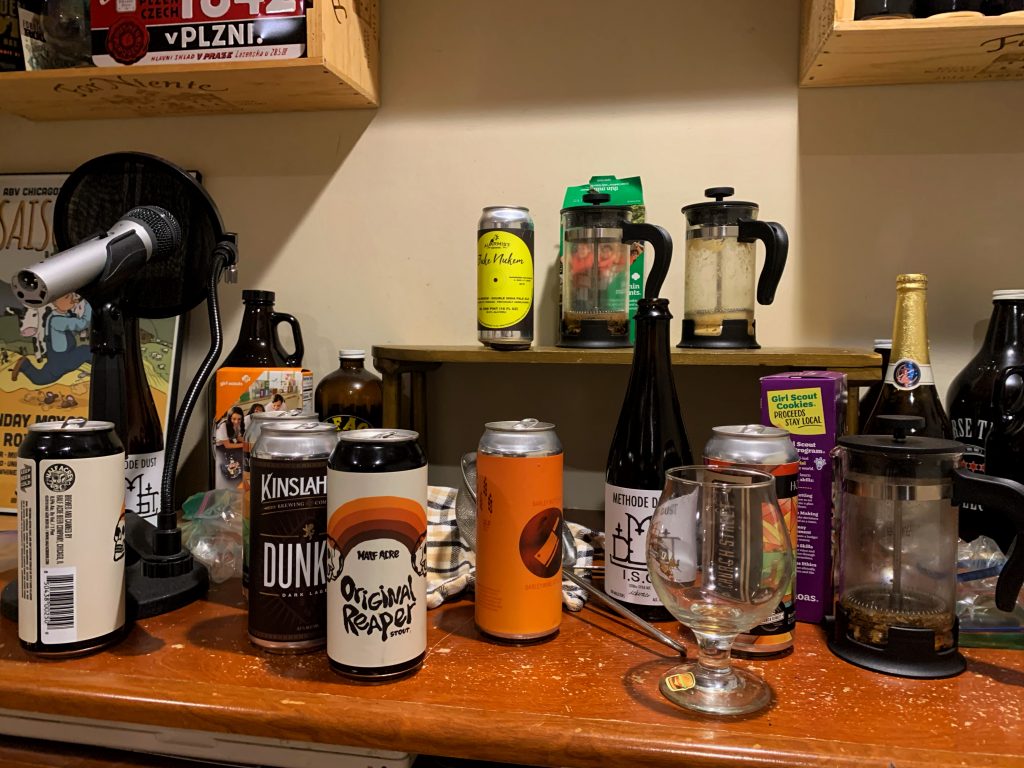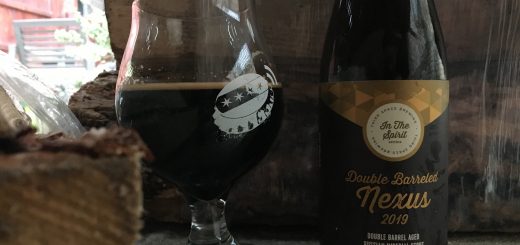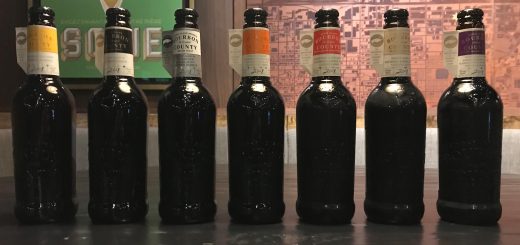The French Press Beer Experiment: Girl Scout Cookie Edition
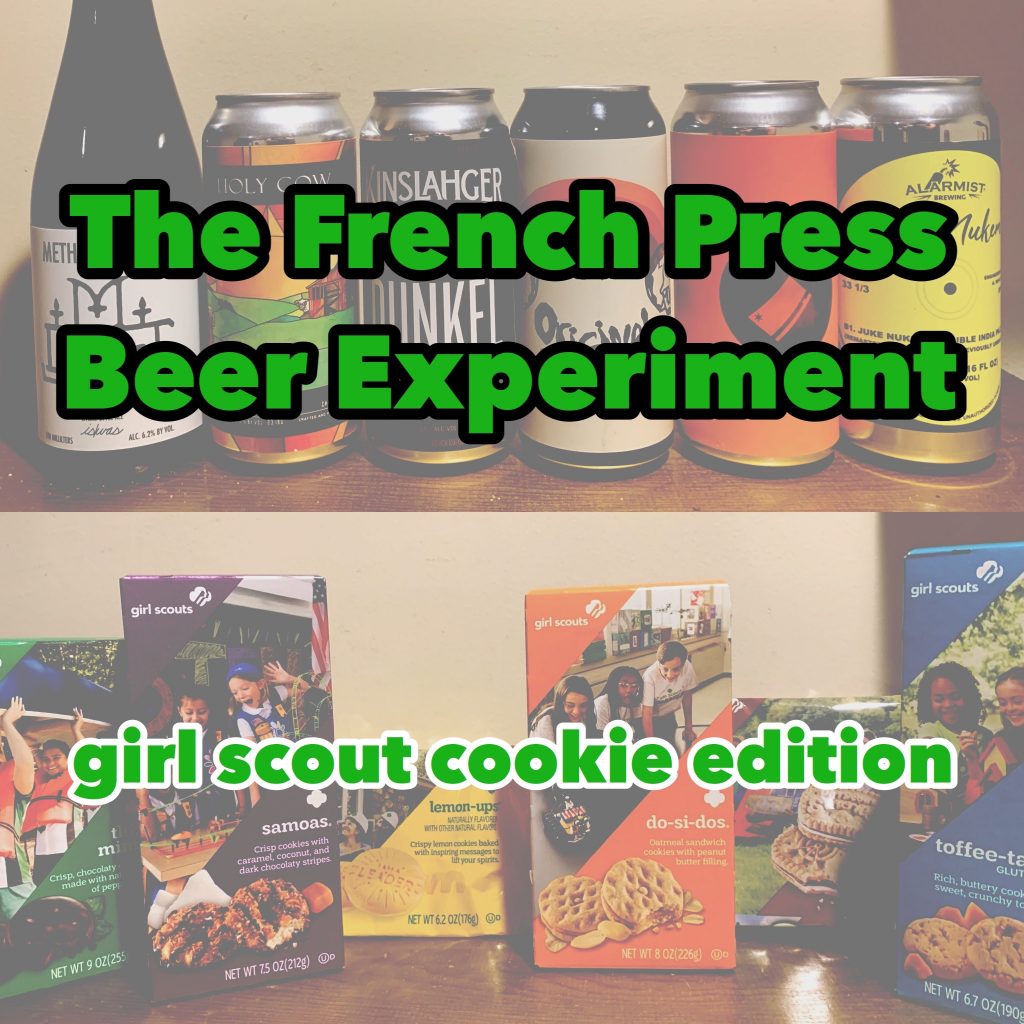
Back in December of 2019 while holiday shopping at IKEA, I came across the UPPHETTA – specifically, the 13.5 oz. model of their French press selling for an absurdly-low $6.99. (The 34 oz. model is only a buck more, by the way.) Thinking specifically about how I could torture my podcast cohost in new and ridiculous ways, I bought three. My intention was to infuse a wide variety of beers with big flavors, somewhat inspired by the “make your own pastry stout” event thrown by The Beer Temple back in May of 2018. And a week before going into a full quarantine, Craig and I set out to record an episode combining local beers of different styles with Girl Scout cookies.
Infusing beer with flavor just before serving is certainly not a new concept, and in fact, Dogfish Head made something of a sport of it back in the 2000s with the introduction of the Randall. (On the Dogfish Head website, the Randall 3.0 for draft systems is currently available at $300 and the Randall Jr. is available for home experimentation at $20.) My first experience with beer poured through a Randall traces back to FoBAB 2013 when Goose Island was infusing their Bourbon County Stout and Bourbon County Barleywine through separate Randalls: the former a searingly-hot serrano pepper stout and the latter a future inspiration for 2018’s Coffee Barleywine variant. (Anecdotally from a Goose employee, this combination was supposedly a mistake, and the lines may have been switched.) But from my experience, it seems that even the brewing world has deemed these Randalls a bit too gimmicky and gaudy, opting more for a more measured approach to flavor-infusion through the use of a firkin (which looks really cool and necessitates you swinging a mallet.)
Since I don’t have a mini-Randall or firkin, and I don’t home brew, a French press was the simplest device for some weird beer experimentation. (They also make a damn fine cup of coffee, of course.) A simple Google search returns many articles on French press experiments with beer, and there are some with a few fun recipe ideas. My methods and timing mentioned below were inspired by this article from Craft Beer Joe on French press infusions in beer. From that post (and common sense, I guess), I surmised that longer time in the press would guarantee a bigger flavor extraction. And since it would be sacrilegious to waste the flavor of perfectly good Girl Scout cookies, I wanted the flavor to be front and center without entirely taking over the beer.
Method
This is the same method I used for all six beers in this article. I will recommend some variations on the method based on the specific infusions and beers, if needed.
But I have two major recommendations (that can be ignored) before you set out to plan your own French press adventure. First, the 13.5 oz. French press from IKEA was perfect for a 12 ounce beer, and even more advantageous with a 16 ounce beer, as you can just chug whatever is left. Secondly, having two beers on hand will help replace some inevitable carbonation loss and balance out the flavors. I knew that I wanted to blend back in some fresh beer to revive its carbonation, so I did pack most of these with more cookies than necessary to make sure the flavor was strong enough to endure blending.
Now onto the process.
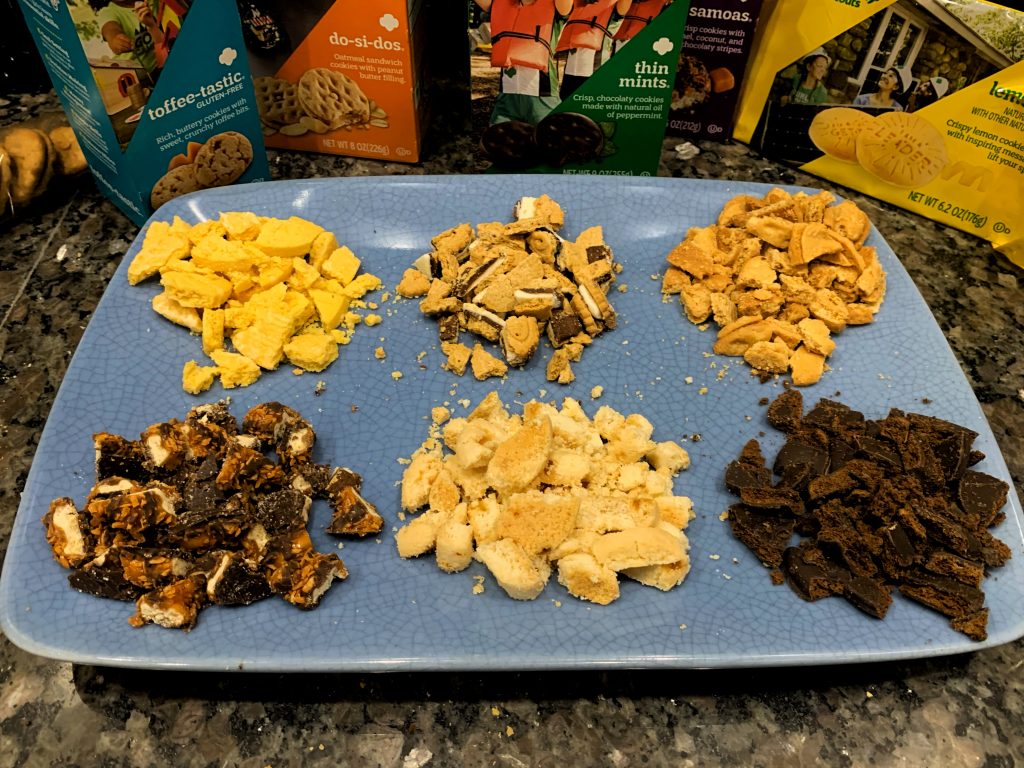
First, use about 1/2 of a cup of roughly chopped cookie chunks. Try to avoid having too much cookie dust with what you chop, unless you like your beer infusion to look like a protein shake. Drop them into the bottom of a clean French press, pour your chosen beer slowly over the chunks and cackle like a mad scientist as enormous bubbles form and a horrifying-looking beer slush mush is left floating in your fancy bean presser.
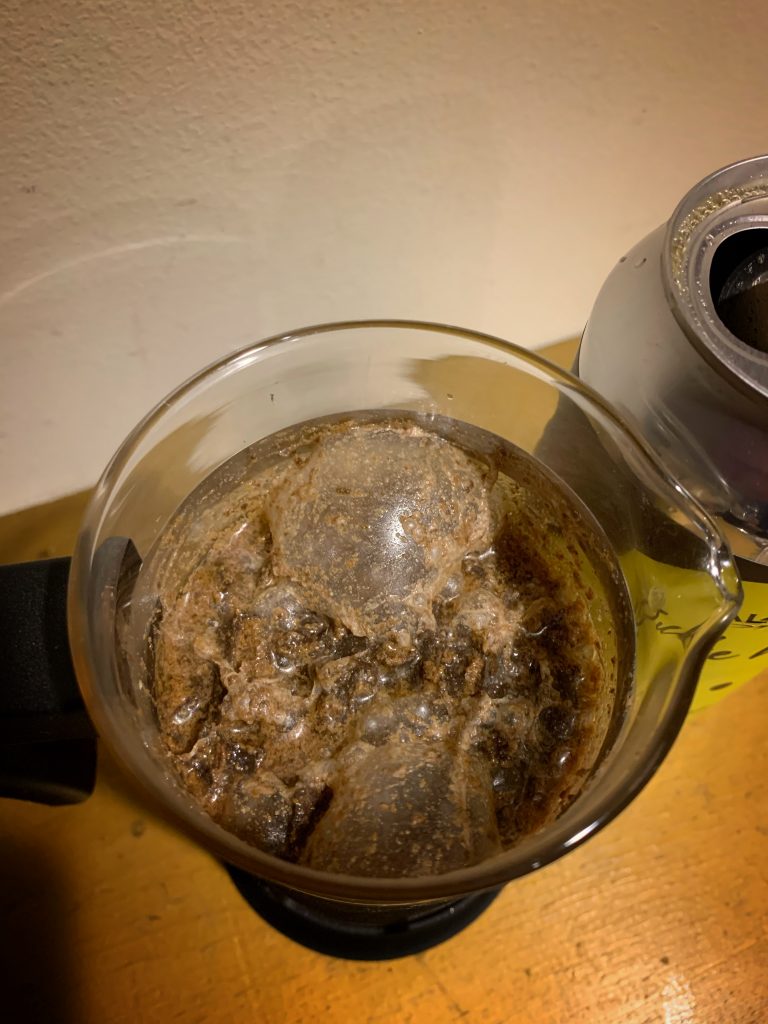
Then, put the top on and leave the plunger up. Place the French press in the fridge for around 20-30 minutes. After that time, press the plunger down slowly. The initial rest time on the chunks should make the cookies extra soft, meaning you can push that sucker down pretty far. Don’t freak out that some particulate matter squeezes past the filter into your beer. (You didn’t actually think clear beer was an option in this thing, did you?) Then, leave the plunged press to rest for an additional 20-30 minutes on the ingredients. Consider your ideal serving temperature based on the style of beer, and either put it back in the fridge or leave it out to rise to more stout-friendly temperatures.
Lastly, pour and enjoy! (I ran mine through another wire mesh filter while pouring it from press to glass to try and catch some of the larger chunks of cookie, and I highly recommend that.)
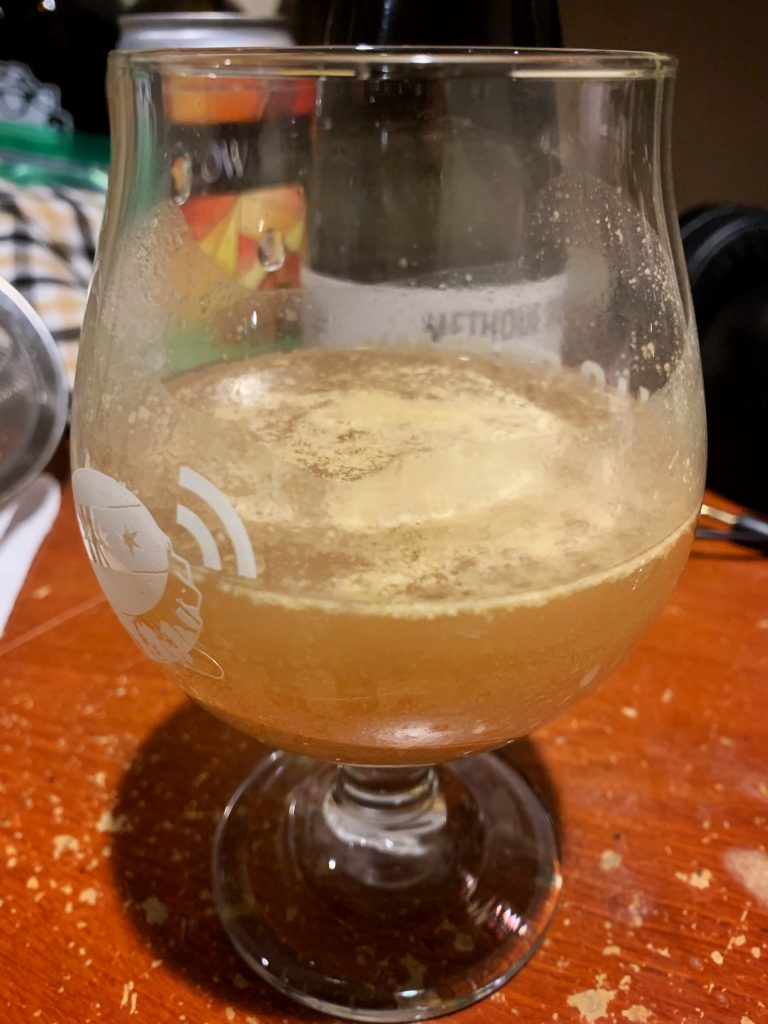
Oh, and don’t get so drunk that you forget to wash the cookie chunks out of your French press, as it’s a pain-in-the-ass to do the next day while your head throbs with a sugar hangover like you’ve never had.
Now onto the results of our experiment. Of course, you can hear us sample all of the base beers we used for this and the resulting cookie combinations on Episode 320 – Girl Scout Cookie Press. Below I’ve collected a few tasting notes, future adjustments, and possible beer substitutions. (Please note: there is no substitution for Girl Scout cookies, but if you must, I’m sure there are other cookies out there with some similar flavors as the ones below. I don’t know. I’m not a scientist.)
Infusion #1: Farmhouse and Lemon
Beer: Is/Was Brewing’s Methode Dust
Cookie: Lemon-Ups®
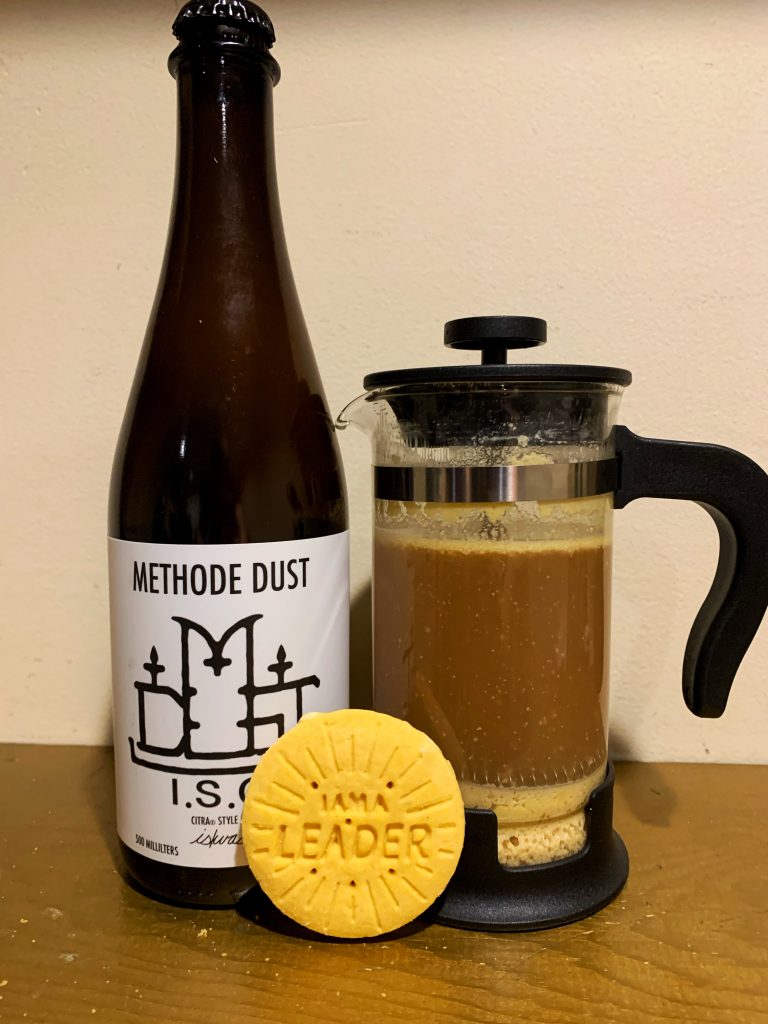
We’re way on board with Mike Schallau’s new project, Is/Was Brewing, due to the focus on saison and Brettanomyces. Methode Dust, a nod to Three Floyds’ Zombie Dust that listeners to The Beer Temple Insiders Roundtable will appreciate, is listed as a “Citra-style ale” on the bottle. It tastes like heavily-hopped saison or amped-up table beer, and surprisingly, looks like a janitor’s mop bucket.
The addition of Lemon-Ups® was intended to bring out the natural citrus imparted from Citra hops and farmhouse yeasts. Instead, we got an intense lemon sugarshake that made our teeth ache. Only after blending in much more of the Methode Dust did we start to taste the potential we had hoped for from the outset: a somewhat tart but definitely sweet dry-hopped lemonade cocktail.
Recommendations: Maybe a more peppery saison or wheat beer would make this fun. We ruined a pretty tasty beer with this one. I’d also cut the infusion time in half and reserve more beer for blending to achieve much-needed carbonation for this style.
Beer Substitutions: Boulevard Tank 7; Allagash River Trip; Off Color Apex Predator; Avery White Rascal; Bell’s Oberon
Infusion #2: Milk Stout and S’mores
Beer: Church Street Brewing’s Holy Cow
Cookie: Girl Scouts S’mores®
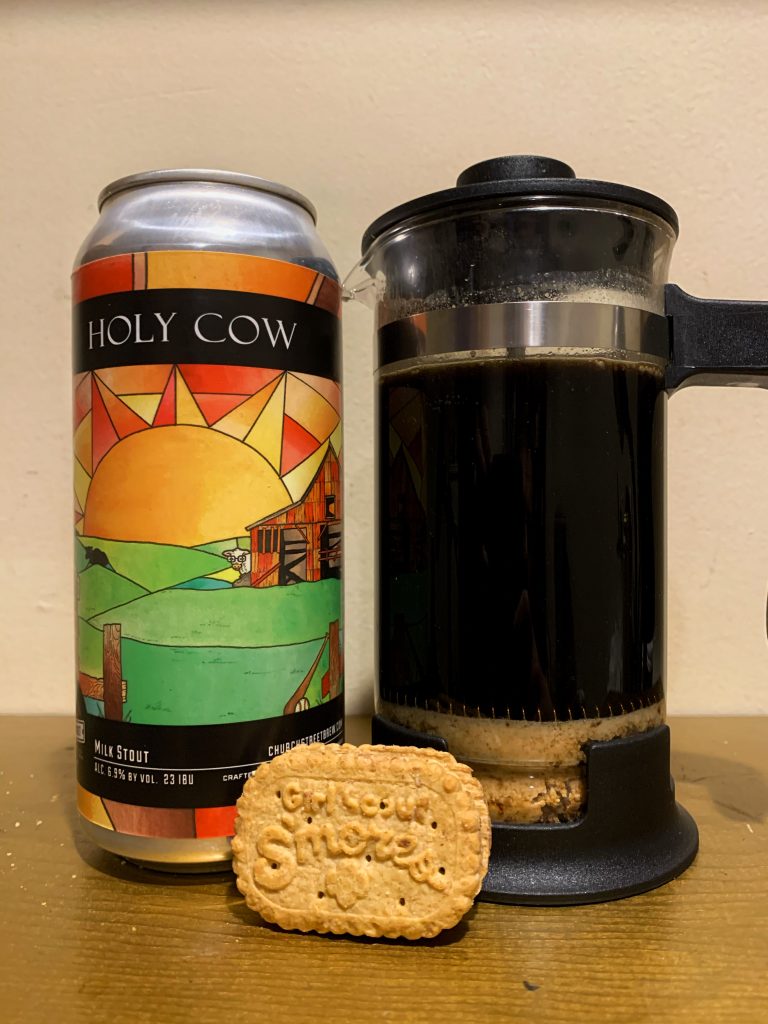
This should’ve been an absolute slam dunk. The base beer here is not the problem: it’s lightly roasty, slightly creamy, with the right amount of chocolate malt. It’s not overly sweet to begin with, which is an asset because we’re adding freakin’ cookies to it.
Somehow, this infusion turned out terrible. What we expected from the cookie – light honey graham cracker, chocolate, marshmallow – was replaced by the taste of iron and blood. Sweetness remained, but not in the way you want it to. This was a quick drain pour.
Recommendations: Don’t? Actually, I used this same cookie for an experiment with Firestone Walker’s Nitro Velvet Merlin and it turned out a lot better than this. The method doesn’t need to change, but something does. Maybe something bigger and roastier would do this cookie well, like an imperial stout. Just don’t complicate it with a stout that has other adjuncts already present.
Beer Substitutions: (not milk stouts) Bell’s Kalamazoo Stout; Two Brothers Northwind; Deschutes Obsidian; North Coast Old Rasputin
Infusion #3: Dunkel and Peanut Butter
Beer: Kinslahger Dunkel
Cookie: Do-Si-Dos®
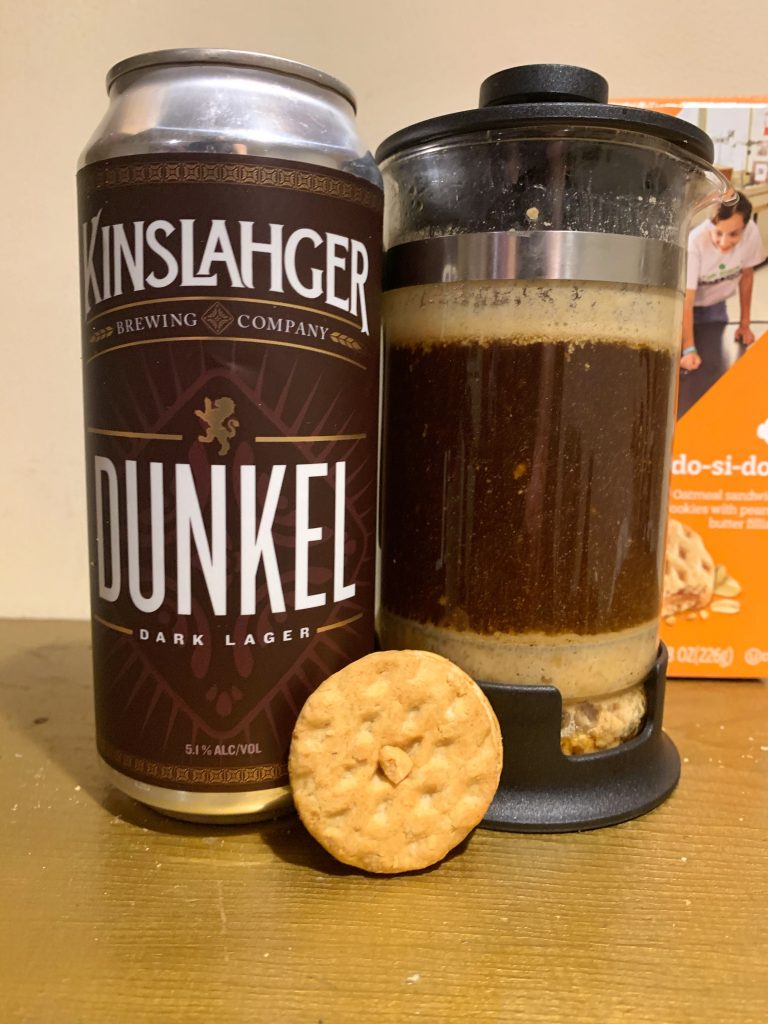
Take my favorite brewery that I can walk to from my house and mix one of my taproom go-tos with my absolute favorite Girl Scout cookie year-to-year, and this combo had a lot to live up to. The Dunkel itself is a wonderful dark lager with flavor notes of light roast coffee and oily nutskin, so our hope in pairing these two was to find the perfect balance of drinkability and, er, peanut butter.
This one worked – and very well! It did veer a bit sweet, of course, and the peanut butter cookie absolutely took over the aroma. Once some more Dunkel was blended back in, though, it gave off big roasted peanut vibes with a still relatively easy-going finish.
Recommendations: Cut the rest time in half for both the pre-plunged and plunged versions, and save plenty of base beer to blend back in. If dunkels are not readily available to you, a good adjunct-free brown ale would certainly suffice.
Beer Substitutions: Cigar City Maduro (Actually, that’s it. This one would be perfect.)
Infusion #4: Stout and Samoa
Beer: Half Acre Beer Company Original Reaper
Cookie: Samoas®
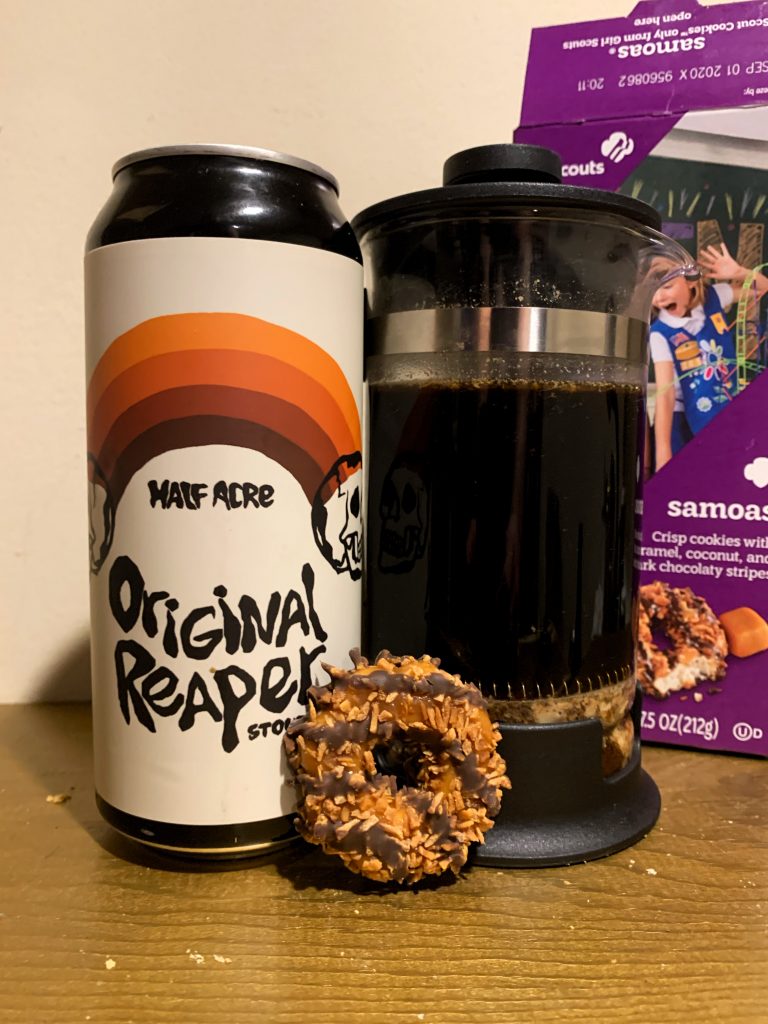
This newer stout in the Half Acre lineup is quietly one of the best things they’ve done in a while. Who makes relatively easy-drinking, adjunct-free stouts anymore? This beer is roasty and bitter and dry without a residual sugar to be found. It’s almost a shame that we decided to do something to it.
Fortunately, this combo worked out very well. The toasted coconut and caramel give this just enough noticeable flavor above the base beer to make the experiment worthwhile. The nature of these sticky and chewy cookies, though, likely made them harder to break down and become more of a feature in this drink.
Recommendations: If you’re using this exact beer, drink one before deciding to ruin it. The original Original Reaper is so good and uncomplicated that you’ll feel bad for desecrating it. But, if you want that big Samoa® flavor to come through, maybe chop the cookies a bit more fine and add some rest time.
Beer Substitutes: Much like the s’more suggestion above, roasty and bitter stouts will play the best here, but they don’t have to be like 10% ABV – this one is 6%. Honestly, if anyone has an idea of an uncomplicated, lower ABV stout with no adjuncts that is somewhat easily available (and not Guinness), I’m all ears.
Infusion #5: Barleywine and Toffee
Beer: Maplewood Barley Butcher
Cookie: Toffee-Tastic®
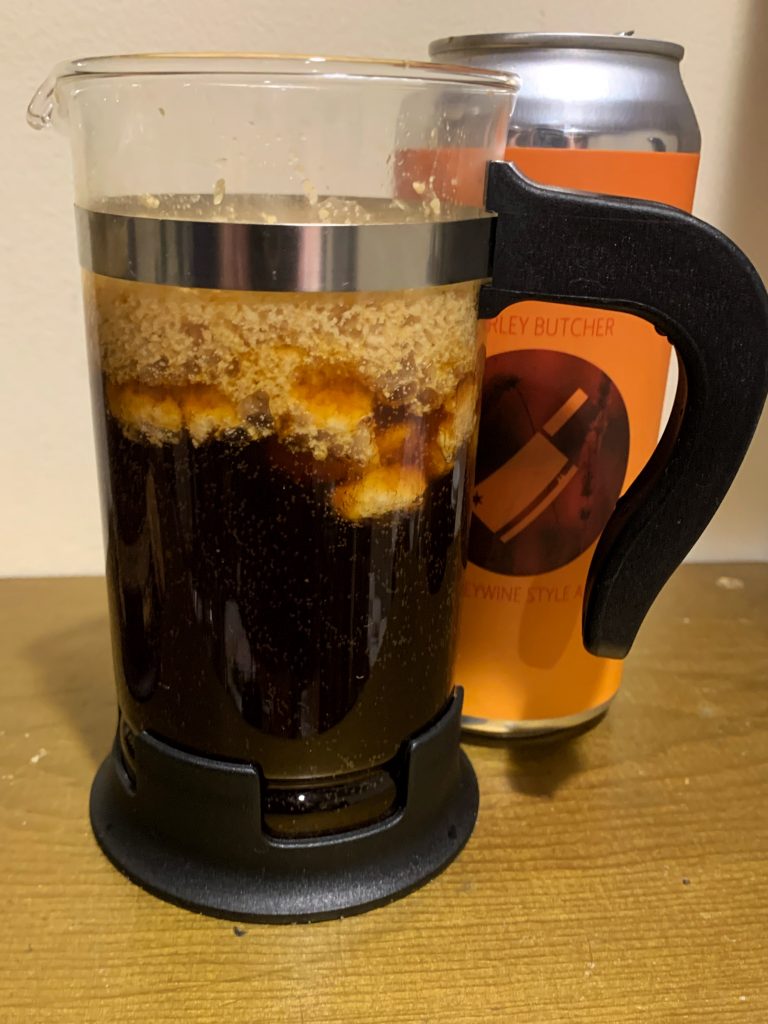
This Maplewood barleywine is listed as an English Barleywine, as its main flavor highlights are the toffee and caramel of the malt over the feature of Columbus and Chinook hops. It even brings out a touch of cherry for an almost Old Fashioned cocktail-like character.
The somewhat grainy consistency of this gluten-free cookie worried me when I was chopping up chunks, as it turned into a fine dust pretty easily. Toffee and barleywine should have just run parallel paths to create a slightly sweeter version of the base. What actually happened was weirder than (almost) anything we would’ve expected. Combined, these two flavors came together to create an undeniable grape candy aroma and flavor, like opening a big old pack of purple Big League Chew. We have no idea why. It wasn’t that bad, but it was one of our least favorite pairings of the bunch, with my least favorite cookie of the lineup.
Recommendations: Avoid obvious cookie and beer pairings! Well, okay, this one was a bit of an anomaly in the results. Definitely run this through a few extra mesh strains, as the cookie trub was significant in this one. Maybe let it rest longer if you really want the cookie to come through as intended.
Beer Substitutions: Anchor Old Foghorn; Revolution Straight Jacket (if you want to play with/ruin an excellent BA beer); an aged North Coast Old Stock Ale
Infusion #6: IPA and Mint Chocolate
Beer: Alarmist Brewing Juke Nukem
Cookie: Thin Mints®
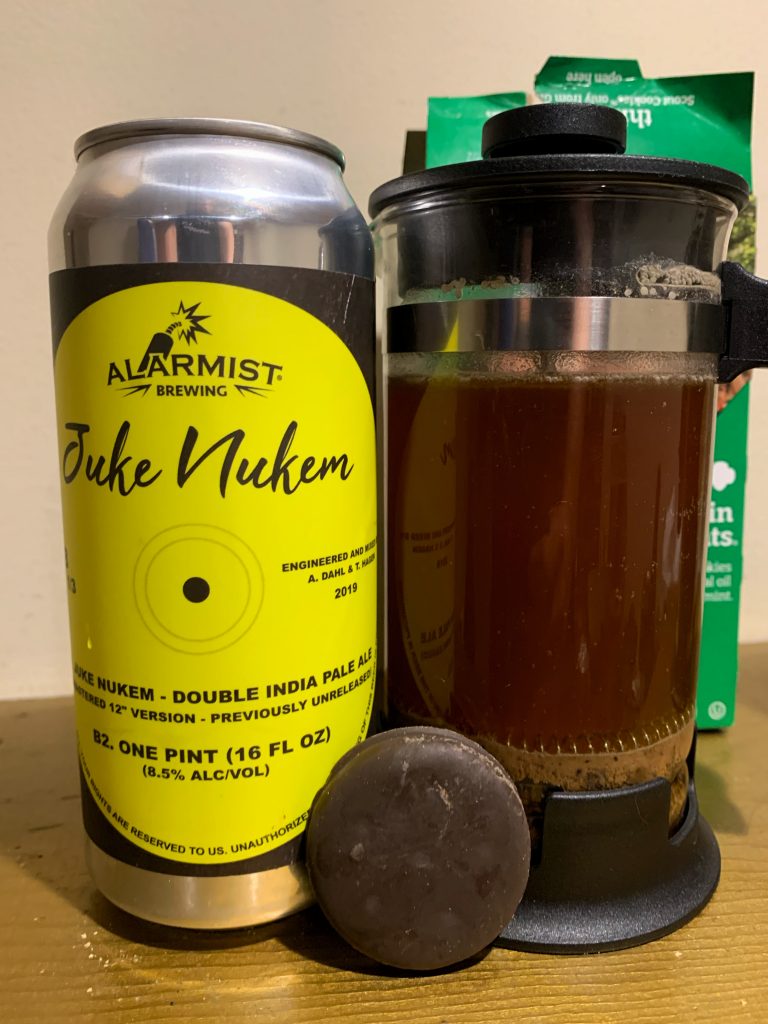
This is Craig’s darling. We both agreed that we needed an IPA on the show, and simultaneously, we said, “Thin Mint IPA.” It’s so stupid. But when we considered what style of IPA, we had to consider what would play the best with mint and chocolate. A West Coast DIPA – big on bitterness and big on booze – could potentially use the mint to elevate the bitterness to something refreshing while letting the chocolate dance among the citrus hop character. This beer from Alarmist is hopped with Simcoe, Centennial, Chinook and CTZ, so we knew we were getting some bitter throwback goodness.
GOOD GOD did this work. Like, if every other combination fell flat, this one made all the mess and destruction of good cookies worth it. As predicted, the mint and bitter hop character are working in tandem, and the mint seems like a natural extension of the herbal grassiness and pine you’d get off of a West Coast IPA. The chocolate is also present but not so present as to lose the underlying citrus of the base beer. It made me wonder why breweries aren’t making chocolate mint IPAs, then I realized just how stupid that sounds. But at least Craig was happy.
Recommendations: DO THIS. The rest time, the cookie amount, the style of beer – it was exactly what we hoped for and more.
Beer Substitutions: Dogfish Head 90 Minute IPA (hell, give a fresh 120 a spin, if you dare); Sierra Nevada Hop Bullet; Lagunitas Hop Stoopid; 3 Floyds Arctic Panzer Wolf
